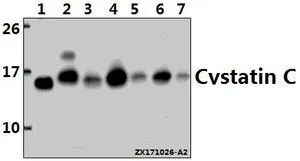
WB analysis of various samples using GTX66728 Cystatin C antibody. Lane1 : PC3 whole cell lysate(20ug) Lane2 : The Brain tissue lysate of Mouse(40ug) Lane3 : C6 whole cell lysate(40ug) Lane4 : HepG2 whole cell lysate(40ug) Lane5 : H1792 whole cell lysate(40ug) Lane6 : HEK293T whole cell lysate(40ug) Lane7 : MCF-7 whole cell lysate(40ug) Dilution : 1:1000
Cystatin C antibody
GTX66728
ApplicationsWestern Blot
Product group Antibodies
TargetCST3
Overview
- SupplierGeneTex
- Product NameCystatin C antibody
- Delivery Days Customer9
- Application Supplier NoteWB: 1:500-1:1000. *Optimal dilutions/concentrations should be determined by the researcher.Not tested in other applications.
- ApplicationsWestern Blot
- CertificationResearch Use Only
- ClonalityPolyclonal
- Concentration1 mg/ml
- ConjugateUnconjugated
- Gene ID1471
- Target nameCST3
- Target descriptioncystatin C
- Target synonymsADLDWA, ARMD11, HEL-S-2, cystatin-C, bA218C14.4 (cystatin C), cystatin 3, epididymis secretory protein Li 2, gamma-trace, neuroendocrine basic polypeptide, post-gamma-globulin
- HostRabbit
- IsotypeIgG
- Protein IDP01034
- Protein NameCystatin-C
- Scientific DescriptionThe cystatin superfamily encompasses proteins that contain multiple cystatin-like sequences. Some of the members are active cysteine protease inhibitors, while others have lost or perhaps never acquired this inhibitory activity. There are three inhibitory families in the superfamily, including the type 1 cystatins (stefins), type 2 cystatins and the kininogens. The type 2 cystatin proteins are a class of cysteine proteinase inhibitors found in a variety of human fluids and secretions, where they appear to provide protective functions. The cystatin locus on chromosome 20 contains the majority of the type 2 cystatin genes and pseudogenes. This gene is located in the cystatin locus and encodes the most abundant extracellular inhibitor of cysteine proteases, which is found in high concentrations in biological fluids and is expressed in virtually all organs of the body. A mutation in this gene has been associated with amyloid angiopathy. Expression of this protein in vascular wall smooth muscle cells is severely reduced in both atherosclerotic and aneurysmal aortic lesions, establishing its role in vascular disease. In addition, this protein has been shown to have an antimicrobial function, inhibiting the replication of herpes simplex virus. Alternative splicing results in multiple transcript variants encoding a single protein. [provided by RefSeq, Nov 2014]
- Storage Instruction-20°C or -80°C,2°C to 8°C
- UNSPSC12352203





![IHC-P analysis of human liver cancer tissue section using GTX01145 Cystatin C antibody [JJ09-16].](https://www.genetex.com/upload/website/prouct_img/normal/GTX01145/GTX01145_20200303_IHC-P_575_w_23053121_796.webp)
